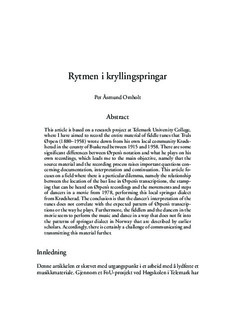| dc.description.abstract | This article is based on a research project at Telemark University College, where I have aimed to record the entire material of fiddle tunes that Truls Ørpen (1880–1958) wrote down from his own local community Krøds - herad in the county of Buskerud between 1915 and 1958. There are some significant differences between Ørpen’s notation and what he plays on his own recordings, which leads me to the main objective, namely that the source material and the recording process raises important questions concerning documentation, interpretation and continuation. This article focuses on a field where there is a particular dilemma, namely the relationship between the location of the bar line in Ørpen’s transcriptions, the stamping that can be heard on Ørpen’s recordings and the movements and steps of dancers in a movie from 1978, performing this local springar dialect from Krødsherad. The conclusion is that the dancer’s interpretation of the tunes does not correlate with the expected pattern of Ørpen’s transcriptions or the way he plays. Furthermore, the fiddlers and the dancers in the movie seem to perform the music and dance in a way that does not fit into the patterns of springar dialect in Norway that are described by earlier scholars. Accordingly, there is certainly a challenge of communicating and transmitting this material further. | |
